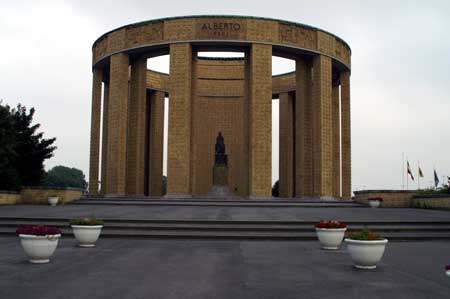
Albert, known here in Belgium as the Knight-King, along with his wife Elizabeth, were king and queen of Belgium as WW One began. Belgium had not joined either alliance and had declared itself neutral, as had Switzerland and the Netherlands. In the course of international politics, that had no bearing for the Germans. They demanded that Albert allow the German army to pass through Belgium on it’s way to France to do an end run around the French army which was stationed all along the French-German border. The Germans fully expected Albert to capitulate and were not pleased when he did not but rather mobilized the Belgian Army. The Germans struck first at Liege, a reasonably well fortified city, thinking they could quickly take that city, move through Antwerp, and west and south from there. Albert instructed his army to resist at all costs and what the Germans expected to do in two days took more than ten days at a significant cost of lives for the Germans. Meanwhile, the British Expeditionary Force was moving in to help defend Antwerp. The Belgian army fell back to Antwerp and defended that city as long as possible, then falling back again to the Ijzer River. Fortified by the British and some French, they made a stand there.
The Germans invaded Belgium on 4 October 1914. On 18 October they were finally at the Ijzer River, a full ten days behind their Grand Plan’s schedule. After seven more days of heavy fighting, the Belgian army was faced once again with the need to fall back. Then a brilliant plan was put forth. Much of this region was below sea level with locks and dikes holding the ocean back. Karel Cogge, the lock keeper, and Hendrik Geeraert, a sea captain, opened the locks so that at high tide the waters would flood the lowlands. It took a couple of days for the full flooding to occur, but it stopped the German advance. Meanwhile, the British and French had also stopped the Germans all along a line south into France. That line would more or less be maintained for the next four years.
The huge memorial to King Albert at Nieuwpoort commemorates the king’s role in this event. Albert was the commander-in-chief and was with his troops (or at least with his officers) during these battles and retreats and at his command the Belgian army was finally able to make a stand that lasted for the remainder of the war. Albert seems to be both venerated and scorned. His military actions earned him the veneration. His failure to keep promises to the Flemish people caused significant problems that lasted through WWII. By not following through on his promise to make the Flemish language equal with French, a near civil war occurred after World War One. That encouraged the Germans during WWII to make promises to the Flemish people, who by that time were all tired of being second-class citizens. Many Flemish dissidents collaborated with the Germans during WWII feeling at that time that the Germans were going to win the war and they wanted to be on the winning side. More than 200 collaborators were executed in the months following the end of WWII. That caused the dissidents to resort to terrorism which further inflamed the Belgian Government. Much violence and bloodshed could have been avoided if Albert had only kept his promise. Politics are never simple and this situation was no exception. The lens of hindsight makes the poor decision-making stand out while I’m sure the events of the day were clouding up everyone’s vision.
Just outside King Albert’s memorial is a large monument to the British soldiers killed in the defense of Antwerp. Around the monument was a very thought-provoking statement. It had essentially no beginning or end — it could just be read around and around. I wrote it down starting at an arbitrary point:
“At the going down of the sun and in the morning we will remember them. They shall grow not old as we that are left grow old. Age shall not weary them nor the years condemn.”
The words on the monument are from the poem “For the Fallen” by Laurence Binyon. It was first published in one of the newspapers in the UK (The Times) on September 21, 1914. It’s supposed to read:
They shall not grow old as we that are left grow old;
Age shall not weary them, nor the years condemn;
At the going down of the sun and in the morning
We will remember them.
This verse is usually read out during the Remembrance Day services around the UK.